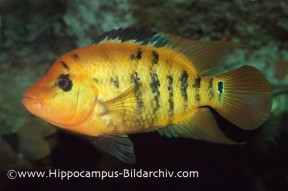Cichlasoma festae
Red Terror
Classification
Cichlidae. subfamily: Cichlasomatinae
Distribution
Ecuador and Peru, with an extant introduced population also thriving in Singapore. Known from both the Rio Esmeraldas in Ecuador and the Rio Tumbes in Peru.
Habitat
A seemingly adaptable species existing in various types of habitat, usually in rivers and their tributaries.
Maximum Standard Length
Males: 20″, Females: 12″
Aquarium SizeTop ↑
84″L x 24″H x 24″W (210cm x 60cm x 60cm) – 793 litres
Maintenance
Make sure there is a lot of swimming area for Cichlasoma festae, but also provide cover in the form of stable rocks and bits of wood. The Red Terror is a digger so plants won’t last long, and because of its size potted plants likely won’t either. Floating plants are an option, as are plants rooted to bits of wood or rock.
Water Conditions
Temperature: 77 to 84°f (25 to 29°c)
pH: 6.0 to 8.0
Hardness: 4 to 18°dH
Diet
Available scientific data suggests the species feeds mainly on benthic aquatic crustaceans and other invertebrates. It also probably consumes on the fry of other fish as well as various fruits and seeds. Omnivorous. Will eat most things offered but a large (physical size), high quality, meaty cichlid pellet is ideal as staple food. The dry foods specifically for large carnivorous cichlids are ideal. Make sure large live and frozen foods are offered regularly, earth and mealworms are ideal.
Behaviour and CompatibilityTop ↑
Very territorial and can sometimes be downright aggressive. Only house with similarly sized, similarly aggressive, robust fish. Anything which the red terror can fit in its large mouth will be seen as food – at full size, this can mean 6″ fish.
Sexual Dimorphism
Females keep their juvenile colours of vivid red with black bands. Males are larger.
Reproduction
The Red Terror is a cave brooder and will lay their eggs in caves or in sheltered areas. Rockwork is usually the best bet, especially with Festae over 12″. A number of spawning pits will be dug in the substrate, then the female will lay upto 3000 large eggs in a sheltered place or cave. Fry will hatch in 3 or 4 days, and will then be moved to the aforementioned spawning pits. Around 5 or 6 days later the fry will be free swimming, but parents will still guard them very carefully.
NotesTop ↑
The Red Terror can be troublesome to breed due to pairing problems – if a pair of fish are incompatible and are housed together for any length of time, it is likely that the weaker fish will be killed. The best way of getting a true pair is to grow 6 juveniles up until a noticeably strong pair has formed. Also, its size means finding an aquarium and suitable breeding surfaces can be difficult. As previously mentioned, rocks (siliconed if necessary) and bits of slate used to create man-made caves are ideal.
Cichlasoma festae is not a fish to be messed with. Its large size and ferocious attitude can lead to some serious issues in an aquarium. Make sure you have a large enough aquarium to begin with, as very few shops (or hobbyists) will take a 12″+ Red Terror off your hands when it grows too large for your tank.
A stunning fish and a challenge to breed, the Red Terror can make an amazing centre piece for any large, predatory south American cichlid setup.



January 12th, 2013 at 8:54 pm
Best regards from Ecuador, the house of Red Terror (Guayas cichlid). These fish are found in the south region from my country, specially in the Guayas River fluvial system, not in the Esmeraldas river. There are other cichlids that come from these waters, at the north of the country, such as the andinocara species.
The red terror is frecuently used in local cuisine.
Of course is one of the favorites in the aquarium hobby too.
February 5th, 2020 at 9:08 pm
I believe this profile wasn’t sorted correctly into the cichlid family.